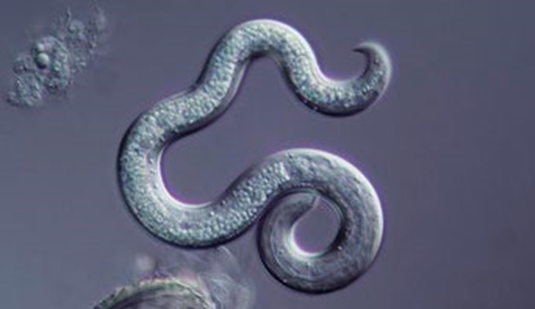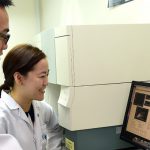Do you remember when we were small kids, we used to play with soil in the playgrounds or our own gardens and sometimes we put our hands or other objects into our mouths. Parasitic infections due to such unhygienic practices may cause abdominal pain and subsequently we were given deworming medicines. One of the parasitic infections that these medicines could combat is toxocariasis.  Toxocariasis is a zoonotic disease transmitted from animals to humans caused by parasitic roundworms commonly found in the intestine of dogs (Toxocara canis) and cats (Toxocara cati). Infected dogs and cats can shed Toxocara eggs in their feces and the eggs are transmitted to humans by accidental ingestion of or contact with the infective eggs. Toxocariasis usually affects kids under the age of 10 years. Children at high risk are those who like to put things or hands in their mouths or kids from families having pet dogs or cats. Most infected individuals do not show any symptoms, but if they do, they can have fever, cough or wheezing, abdominal pain, enlarged liver or spleen, poor appetite, a rash that sometimes looks like hives, and enlarged lymph nodes (“swollen glands”). Some people may develop ocular toxocariasis if the Toxocara larvae migrate to the eye. Symptoms and signs of ocular toxocariasis include vision loss, eye inflammation or damage to the retina. Besides that, visceral toxocariasis occurs when Toxocara larvae migrate to other body organs, such as the liver or central nervous system. Symptoms of visceral toxocariasis include fever, fatigue, coughing, wheezing, or abdominal pain. As many of the symptoms of toxocariasis are nonspecific and mild, diagnosis of the disease can be quite difficult. So in addition to taking patient history to determine exposure to risks, laboratory investigations serve as vital means for diagnosis and confirmation of the disease. Classical T. canis excretory–secretory (TES)-based enzyme-linked immunosorbent assay (ELISA) is the gold standard for toxocariasis detection. Nevertheless, the method is laborious and can only be done in a laboratory setting. Such limitations inevitably resulted in the delay of proper diagnosis especially for populations in remote or rural areas. Due to these shortcomings, several rapid and portable field detection kits had been developed over the recent years. (Akao et al., 1997; Lim et al., 1999; Bojanich et al., 2012; Yamasaki, 2012).
Toxocariasis is a zoonotic disease transmitted from animals to humans caused by parasitic roundworms commonly found in the intestine of dogs (Toxocara canis) and cats (Toxocara cati). Infected dogs and cats can shed Toxocara eggs in their feces and the eggs are transmitted to humans by accidental ingestion of or contact with the infective eggs. Toxocariasis usually affects kids under the age of 10 years. Children at high risk are those who like to put things or hands in their mouths or kids from families having pet dogs or cats. Most infected individuals do not show any symptoms, but if they do, they can have fever, cough or wheezing, abdominal pain, enlarged liver or spleen, poor appetite, a rash that sometimes looks like hives, and enlarged lymph nodes (“swollen glands”). Some people may develop ocular toxocariasis if the Toxocara larvae migrate to the eye. Symptoms and signs of ocular toxocariasis include vision loss, eye inflammation or damage to the retina. Besides that, visceral toxocariasis occurs when Toxocara larvae migrate to other body organs, such as the liver or central nervous system. Symptoms of visceral toxocariasis include fever, fatigue, coughing, wheezing, or abdominal pain. As many of the symptoms of toxocariasis are nonspecific and mild, diagnosis of the disease can be quite difficult. So in addition to taking patient history to determine exposure to risks, laboratory investigations serve as vital means for diagnosis and confirmation of the disease. Classical T. canis excretory–secretory (TES)-based enzyme-linked immunosorbent assay (ELISA) is the gold standard for toxocariasis detection. Nevertheless, the method is laborious and can only be done in a laboratory setting. Such limitations inevitably resulted in the delay of proper diagnosis especially for populations in remote or rural areas. Due to these shortcomings, several rapid and portable field detection kits had been developed over the recent years. (Akao et al., 1997; Lim et al., 1999; Bojanich et al., 2012; Yamasaki, 2012).  Prof Patricia Lim Kim Chooi from International Medical University’s School of Medicine and her team had conducted a study to evaluate and compare the sensitivity and specificity between a rapid diagnostic kit (RDT) and ELISA for the diagnosis of toxocariasis. The paper was successfully published in Acta Tropica, 2015; 148: 32–37. The study site selected was the Serendah Orang Asli village located in Hulu Selangor about 60km away from Kuala Lumpur, Malaysia. The village has a population of about 250 people who are from the Temuan tribe. The study was conducted in December 2013 with the study population comprising of a total of 133 participants aged between 6 months to 62 years old. The overall prevalence of toxocariasis as detected by RDT was 33.1%, higher than that detected using ELISA (29.3%) with more positive cases detected in males than females. However, no association was found between toxocariasis and gender or age. The percentage sensitivity, specificity, positive predictive value and negative predictive value of RDT were 85.7%, 90.1%, 80% and 93.2%, respectively. Overall, the prevalence rate of toxocariasis detected in the Serendah Village (29.3–33.1%) was similar to that reported for the survey conducted on the Malaysian aborigines by Hakim et al., 1992 (31.2%), but lower than the recent survey on the Semelai and Temiar aboriginal tribes (75.9%) from the northern states of Malaysia (Kelantan and Pahang) (Romano et al., 2010). The rather high prevalence rate in our study is probably because in this village, a number of households kept dogs as pets as well as stray dogs were often seen wandering around the vicinity of the houses and the majority of children in the village walked around bare-footed.
Prof Patricia Lim Kim Chooi from International Medical University’s School of Medicine and her team had conducted a study to evaluate and compare the sensitivity and specificity between a rapid diagnostic kit (RDT) and ELISA for the diagnosis of toxocariasis. The paper was successfully published in Acta Tropica, 2015; 148: 32–37. The study site selected was the Serendah Orang Asli village located in Hulu Selangor about 60km away from Kuala Lumpur, Malaysia. The village has a population of about 250 people who are from the Temuan tribe. The study was conducted in December 2013 with the study population comprising of a total of 133 participants aged between 6 months to 62 years old. The overall prevalence of toxocariasis as detected by RDT was 33.1%, higher than that detected using ELISA (29.3%) with more positive cases detected in males than females. However, no association was found between toxocariasis and gender or age. The percentage sensitivity, specificity, positive predictive value and negative predictive value of RDT were 85.7%, 90.1%, 80% and 93.2%, respectively. Overall, the prevalence rate of toxocariasis detected in the Serendah Village (29.3–33.1%) was similar to that reported for the survey conducted on the Malaysian aborigines by Hakim et al., 1992 (31.2%), but lower than the recent survey on the Semelai and Temiar aboriginal tribes (75.9%) from the northern states of Malaysia (Kelantan and Pahang) (Romano et al., 2010). The rather high prevalence rate in our study is probably because in this village, a number of households kept dogs as pets as well as stray dogs were often seen wandering around the vicinity of the houses and the majority of children in the village walked around bare-footed.  It was reported that RDT is rapid and easy to conduct. The findings from Prof Patricia’s study showed that RDT was more sensitive than ELISA. It is also noteworthy that Prof Patricia’s study cohort mainly composed of children aged 1-10 who have generally lower antibody levels than that of the adults. Hence, the high positive rate observed among this group (26.8-33.8%) highly suggests that RDT is sensitive enough to detect low levels of anti-Toxocara antibody. Furthermore, the RDT device is compact and highly portable. It thus has the potential to be modified for field application and may be useful for field survey in remote or rural areas. In conclusion, the RDT kit was faster and easier to use than an ELISA and is useful for the laboratory diagnosis of hospitalised cases of toxocariasis. References Akao, N., Chu, A.E., Tsukidate, S., Fujita, K., 1997. A rapid and sensitive screening kit for the detection of anti-Toxocara larval ES antibodies. Parasitol. Int. 46,189–195. Bojanich, M.V., Marino, G.L., López, M.Á., Alonso, J.M., 2012. An evaluation of thedot-ELISA procedure as a diagnostic test in an area with a high prevalence of human Toxocara canis infection. Mem. Inst. Oswaldo Cruz. 107, 194–197. Hakim, S.L., Mak, J.W., Lam, P.L.W., Nazma, S., Yahaya, N., 1992. Seroprevalence of Toxocara canis antibodies among Orang Asli (Aborigines) in Peninsular Malaysia. Southeast Asian J. Trop. Med. Public Health 23, 493–496. Lim, P.K.C., Yamasaki, H., Araki, K., Taib, R., Tan, S.K., Choo, T.L., Zasmy, N., Mak, J.W.,Cardosa, M.J., 1999. Immunodiagnosis of human toxocariasis using a recombi-nant fusion protein antigen: development and comparison of three formats. Int.Med. Res. J. 3, 67–72. Lim, P. K. C., Yamasaki, H., Mak, J. W., Wong, S. F., Chong, C. W., Yap, I. K. S., .Ambu, S., Kumarasamy, V., 2015. Field evaluation of a rapid diagnostic test to detect antibodies in human toxocariasis. Acta tropica, 148, 32-37. Romano, N., Nor Azah, M.O., Rahmah, N., Lim, Y.A.L., Rohela, M., 2010. Seroprevalence of toxocariasis among Orang Asli (Indigenous people) in Malaysia using two immunoassays. Trop. Biomed. 27, 585–594. Yamasaki, H., 2012. Toxocariasis. Shonika (Pediatrics) 54, 65–72 (in Japanese).
It was reported that RDT is rapid and easy to conduct. The findings from Prof Patricia’s study showed that RDT was more sensitive than ELISA. It is also noteworthy that Prof Patricia’s study cohort mainly composed of children aged 1-10 who have generally lower antibody levels than that of the adults. Hence, the high positive rate observed among this group (26.8-33.8%) highly suggests that RDT is sensitive enough to detect low levels of anti-Toxocara antibody. Furthermore, the RDT device is compact and highly portable. It thus has the potential to be modified for field application and may be useful for field survey in remote or rural areas. In conclusion, the RDT kit was faster and easier to use than an ELISA and is useful for the laboratory diagnosis of hospitalised cases of toxocariasis. References Akao, N., Chu, A.E., Tsukidate, S., Fujita, K., 1997. A rapid and sensitive screening kit for the detection of anti-Toxocara larval ES antibodies. Parasitol. Int. 46,189–195. Bojanich, M.V., Marino, G.L., López, M.Á., Alonso, J.M., 2012. An evaluation of thedot-ELISA procedure as a diagnostic test in an area with a high prevalence of human Toxocara canis infection. Mem. Inst. Oswaldo Cruz. 107, 194–197. Hakim, S.L., Mak, J.W., Lam, P.L.W., Nazma, S., Yahaya, N., 1992. Seroprevalence of Toxocara canis antibodies among Orang Asli (Aborigines) in Peninsular Malaysia. Southeast Asian J. Trop. Med. Public Health 23, 493–496. Lim, P.K.C., Yamasaki, H., Araki, K., Taib, R., Tan, S.K., Choo, T.L., Zasmy, N., Mak, J.W.,Cardosa, M.J., 1999. Immunodiagnosis of human toxocariasis using a recombi-nant fusion protein antigen: development and comparison of three formats. Int.Med. Res. J. 3, 67–72. Lim, P. K. C., Yamasaki, H., Mak, J. W., Wong, S. F., Chong, C. W., Yap, I. K. S., .Ambu, S., Kumarasamy, V., 2015. Field evaluation of a rapid diagnostic test to detect antibodies in human toxocariasis. Acta tropica, 148, 32-37. Romano, N., Nor Azah, M.O., Rahmah, N., Lim, Y.A.L., Rohela, M., 2010. Seroprevalence of toxocariasis among Orang Asli (Indigenous people) in Malaysia using two immunoassays. Trop. Biomed. 27, 585–594. Yamasaki, H., 2012. Toxocariasis. Shonika (Pediatrics) 54, 65–72 (in Japanese).









